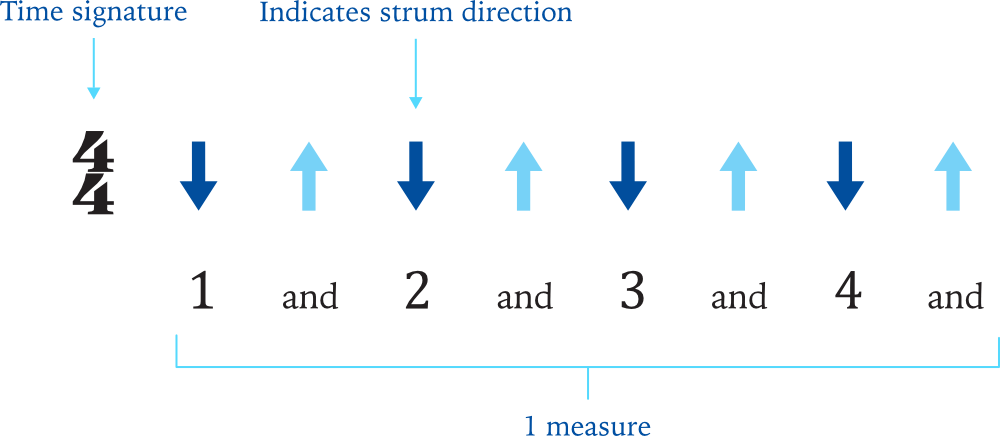This lesson covers 12 easy and practical guitar strumming patterns that will help you improve your playing. Strumming is an essential part of playing guitar because it’s what connects harmony (the chords) with rhythm.
You can use nice chords but without being able to strum properly, your delivery falls short.
We’ll first clarify some basic terms and concepts on strumming and time signatures before getting into the examples. Grab your guitar and let’s get started!
What is a strumming pattern?
As the name suggests, a strumming pattern is a rhythm that you can repeat when playing a chord or a series of chords.
Strumming is one of the most essential skills as a guitarist to be able to deliver the chords you know. Learning basic strumming patterns is one way to help you develop this skill because it gives you insight into what rhythms sound good and also how you can develop other strumming ideas.
Before learning different patterns, we’ll review some important information on time signatures. You can skip over to the strumming examples if you already know this.
Quick review on time signatures
Whether you are just starting out or already having experience playing different rhythms, it’s essential to know how to play strumming patterns in different time signatures.
A time signature indicates the length of each measure, which is a fragment of time that repeats throughout a song.
Common time signatures
- 4/4 time signature, indicates 4 beats in one measure.
- 3/4 time signature, indicates 3 beats in one measure.
- 6/8 time signature, indicates 6 beats in one measure.
To understand this more in-depth, you can check out this simple guide to understanding time signatures.
Let’s look at some basic guitar strumming patterns in different time signatures.
How to read the strumming patterns
The strumming patterns will be displayed in visual form using arrows and also in standard notation.
- Time signature indicated in the beginning
- Arrow down means to strum the strings from the thicker to thinner strings.
- Arrow up means to strum the strings from the thinner to thicker strings.
- ‘Ands’ represent the eight notes in between each beat.

Strumming patterns in 4/4 time signature
We’ll look at four examples in each of the time signatures we mentioned earlier. When there is no arrow on a beat, you can keep the sound of the chord you’re playing.
I recommend repeating/looping each example so that you get a better feel of the strumming pattern. Once you’re able to, start memorizing it and play it without look at the chart.
Choose any chord you like to play the examples. I recommend reviewing these basic chords lesson before learning the following strumming patterns.
Strumming pattern 1
I am using a G Major chord to play these examples which can listen to below each strumming pattern. Each example is repeated for 2 measures.
This first pattern is very straightforward but you want to be able to master strumming up and down consistently as your foundation to then learn other strumming patterns and variations.

Strumming pattern 2

Strumming pattern 3

Strumming pattern 4

Strumming patterns in 3/4 time signature
Strumming pattern 5

Strumming pattern 6

Strumming pattern 7


Strumming pattern 8

Strumming patterns in 6/8 time signature
Strumming pattern 9

Strumming pattern 10

Strumming pattern 11
Strumming pattern 11

Strumming pattern 12

Backing tracks to practice strumming patterns
These backing tracks are drum tracks for you to practice the strumming patterns we just covered. No harmony is added so that you can play whatever chords you choose over the backing track.
I recommend starting with the backing tracks at a slower tempo and then trying it at the faster tempo.
*bpm = beats per minute
4/4 time signature (80 bpm)
4/4 time signature (100 bpm)
3/4 time signature (80 bpm)
3/4 time signature (100 bpm)
6/8 time signature (60 bpm)
6/8 time signature (80 bpm)
Tips for improving your strumming
- Use a metronome or backing track to improve the timing of your strumming. Always start at a slower tempo and gradually bring up the tempo as you feel more comfortable with a pattern. Here is a free metronome on our site.
- Start with one chord at a time. Once you get the pattern down, try switching between other chords and keeping the pattern going.
- Learn strumming patterns from songs you like. This can give you greater motivation to learn a pattern, as well as work on transitioning between chords.
- Learn to mute to create interesting percussive effects to your strumming. This is done by stopping the string instead of letting a chord ring out.
- Think like a drummer. Try rhythmic variations in your strumming to create more interest. Think about how you can make the strumming sound better by incorporating mutes, silence, or extending the length of certain strums.
- Try recording yourself. Record yourself playing different patterns to hear what you can enhance or change. This can be a fun way to develop musical ideas for strumming. You can also experiment with layering different guitar parts.
You can also check out 7 ways to get better at strumming on guitar for more details.
Wrapping up
We covered 12 easy strumming patterns in different time signatures as a guide to get you started. Feel free to combine patterns with the same time signature and experiment with patterns that sound good to you.
As you keep learning new strumming patterns and playing along with songs you like, strumming will come more naturally to you and your sense of musicality will improve.
Learning strumming patterns can also help you improve your sense of rhythm and challenge you to get better at switching between chords in time.
If you’re getting started, I suggest isolating some of your practice time specifically to strumming. You can practice strumming patterns as a part of your practice routine which I talk about in the free guitar practice guide to help you stay on track of your musical goals.
If you want to learn more complex rhythms using a fingerpicking technique, check out how to play Bossa Nova rhythms on guitar.
📘 Get the free guitar practice guide here!
All the best,
JG Music Lessons
Original photo by Jefferson Santos on Unsplash
📙 Kickstart your guitar playing with our step by step guide: Guitar Essentials.
🎸 Looking for a travel or half-sized guitar? See this one.
🛠 See our other music recommendations.
🤝 Support the site to help us to create better content for you!
Level up with the FREE guitar practice guide and effectively improve your playing! 🎸
Get it sent to your email!



